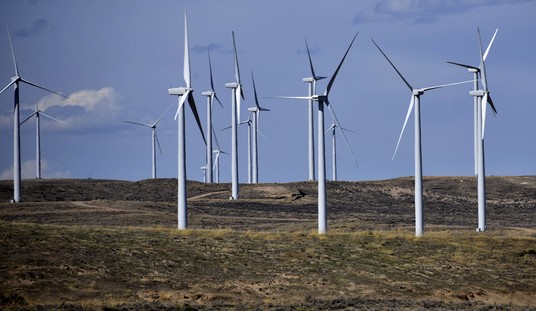The Biden administration's Energy Secretary Jennifer Granholm was mocked last Sunday after she claimed that middle-class Americans struggling to afford groceries in this inflation-ravaged economy can shrink energy costs by installing solar panels on their homes at a 30% discount under the falsely labeled Inflation Reduction Act.
When defending green-energy incentives offered by the massive spending package, President Joe Biden's head of the U.S. Energy Department said the expensive climate-change legislation, which is estimated to already cost the working class at least $20 billion in new taxes, will provide thousands of dollars in tax rebates for lower-income households to upgrade their homes to supposedly be more energy efficient. "If you are low income, you can get your home entirely weatherized through the expansion from the bipartisan infrastructure laws, a significant expansion. You don't have to pay for anything," Granholm asserted on "Fox News Sunday."
"If you want heat pumps, insulation, new windows, that is covered," Granholm stated. "If you are moderate income, today you can get 30% off the price of solar panels. Those solar panels can be financed, so you don't have to have the big outlay at the front," Granholm said, reiterating that "it's a significant incentive."
Biden Energy Secretary Jennifer Granholm: “If you are low-income, you can get your home entirely weatherized” to help deal with 40-year high inflation.
— RNC Research (@RNCResearch) August 21, 2022
“You can get 30% off the price of solar panels.” pic.twitter.com/qUM7JGvdYN
(Reminder: This is the same Biden official who laughed at a question about rising gas prices and increasing domestic oil production in America. "That is hilarious," Granholm chuckled to Bloomberg Surveillance.)
"If you don't qualify for the weatherization program, you will be able to, starting next year, get rebates on the appliances and equipment that will help you reduce your monthly energy bill by up to 30%," an on-air Granholm said of the Green New Deal-style initiative, declaring: "That is all about reducing costs for people."
While she's touting a 30% off coupon, it still means you're reaching into the wallet for a pricey investment that's not fit for most of Middle America. And some skeptics in the energy industry are questioning if solar panels that generate renewable solar power are even environmentally friendly in the long run. Let's shine a light on the subject. Here's the shadowy side of solar energy that the Biden administration is keeping you in the dark about:
The Real Cost
Let's reduce reliance on fossil fuels, decrease our eco-footprint, and help cut down greenhouse gasses while slashing the electric bill. Sounds like a good deal, huh? As our parents taught us, if it sounds too good to be true, it probably is—an adage that universally applies. There are indeed other financial and logistical factors at play. This financing Granholm speaks of is a euphemism for debt. It's similar to how colleges would bill loans as financial aid, which is still money that recipients borrow and must pay back with interest, but it makes the bottom line more bearable at the start of a semester. Although, our poor penny-conscious parents know one of the first life lessons you learn at an early age in the adult world is that there's no such thing as a free lunch. Someone is always picking up the tab somewhere, and most likely it's you at the end of the day.
Recommended
(Granholm's out-of-touch solar panel salesmanship rivals the EV rhetoric of Transportation Secretary Pete Buttigieg who advises U.S. consumers troubled by high gas prices to just purchase an electric vehicle. The lemmings flocking to the latest hipster trend of harnessing solar power are likely the same beachside socialites sipping on mimosas in Martha's Vineyard. They're certainly not Americans living paycheck-to-paycheck.)
Although it's estimated that solar panels can save the typical American family over $1,400 in electrical costs each year, per SolarReviews.com, the seemingly significant savings are countered by a hefty upfront cost that takes tons of time to cover. Like other products, the price of solar panels varies by brand and retailer. Solar quotes site EnergySage places the current installation price in 2022 for an average-sized U.S. home between $17,500 and $23,500 after taking into account the federal solar tax credit. However, panels only comprise a fraction of the total cost of installing a solar system. Ongoing maintenance and additional equipment, like inverters and solar batteries that store electricity for later non-sunny times, make up the remaining charges.
So are solar panels beneficial for your piggy bank and planet Earth? Is this home improvement project cost-effective? Let's break down the real price. Homeowners seeking to install solar panels have the option of paying cash, taking out a lease, or applying for a loan—be it a personal or a government-allotted one.
First, loans allow homeowners to pay off the cost of a solar panel installation over the course of several years, rather than paying out of pocket. An unsecured personal loan means homeowners don't have to put up collateral for the loan as opposed to a secured personal loan, which requires something of equal value to be wagered as collateral. The latter tends to have a lower interest rate because the lender knows they're able to sell the collateral and recoup losses in the event the borrower fails to make the monthly payments.
Similarly, a home equity loan allows homeowners to borrow money from the equity in their homes. But because property serves as collateral, the bank has the right to repossess the residence if a homeowner fails to make payments on the loan. The risk of losing one's home is, of course, very serious business. There are complications, too, if a borrower wanting to sell his or her home has an outstanding home equity loan. That's not an attractive "For Sale" sign. Borrowers are allowed to put their home up for sale with an outstanding loan attached to it, but they'll need to sell it for a high enough price to pay off the balance. The loan itself goes with the property as a lien and must be transferable to the new buyer. Any lien that has been filed in connection with the solar panels must be subordinated to the mortgage at closing or it can be removed and re-filed afterward. While some manufacturers will allow a temporary removal of a lien, if a homeowner is still paying off the balance of the solar panels, there could be a lien on the home until the system is paid for, NJ Lenders Corp. explains.
Homeowners can also apply for a government loan through a Federal Housing Administration (FHA) program called PowerSaver and choose between the PowerSaver Second Mortgage or the PowerSaver Energy Rehab, 203(k) Loan. To qualify, borrowers will need to meet certain qualification requirements, such as a minimum credit score of 660 and a debt-to-income ratio of 45%. The former allows homeowners to take out a second mortgage of up to $25,000, but to be eligible, applicants cannot have an existing home equity loan, second lien, or a second mortgage. Partakers have up to 20 years to repay the loan. The 203(k) loan is for anyone buying or refinancing a home who would like to roll the price of upgrades into the new loan. They're given the entire length of the mortgage to repay the debt. The repayment term is more than twice as long as personal loans carry, but over the 20-year period, homeowners could want to replace solar components before the loan is paid in full. FHA's financing limits apply, meaning that homeowners must stay under its spending threshold.
As for leasing, instead of purchasing one's own solar panels, homeowners can "rent" them. The appeal is that companies often offer lease programs with no money down, but during a home sale transaction, the lease will have to be transferred to the new buyer. More cons include that homeowners won't receive tax credits, will never own the solar panels outright—which won't be treated as a fixture of the property or sold as part of the real estate—and will miss out on the purported solar incentives that help to reduce startup and maintenance costs. Appraisers will not count the panels in the valuation since ownership is viewed as directly owning the asset. If the panels are owned, homeowners will see a value adjustment on the appraisal, though it wouldn't be "too much of a bump," according to The Mortgage Brothers Team. So if a homeowner spends $20,000 on a solar panel system, it might be a mere $5,000 adjustment. In some cases, the adjustments won't even appear if the comparable sales in the neighborhood don't demonstrate that solar panels give appreciable value.
It's possible to change the name on the lease agreement, but it can complicate the sale process if a homebuyer may not qualify since a lease needs to meet a criterion that includes running a credit check. Sometimes, the lease agreement allows the homeowner to buy out the remainder of the lease, but it comes at a price. If the buyer is unwilling or unable to continue the lease agreement, then sellers hope that the leases have clauses that authorize the solar company to transfer the panels to a new home. In other cases, the buyer and seller have to reach an agreement where the home shoppers are credited for the cost of buying out the solar contract as part of the sale price of the house. Either way, this must be settled before the mortgage lender will finalize the deal.
Speaking of which, how do solar panels affect the mortgage and closing process for buyers as well as sellers? Do solar panels increase home value? Homeowners will need to consider how solar panel payments may figure into their debt-to-income ratio. Large solar payments could lead to higher interest rates or to the denial of a mortgage offer. Most mortgage lenders will not finance a house with an existing lien, which means that the solar panel provider will need to agree to temporarily release the lien until after the purchase, then restore it later, renewable energy company Renogy says. Knowing the answers to these key personal finance questions is vital to make sure that homeowners know exactly what they're paying for when solar panel shopping.
Before homeowners take the solar plunge, prospects should ensure there's an existing warranty for the equipment. Oh, and by the way, many solar-equipped homes also need a second energy source other than solar power. Mortgage lenders like Fannie Mae restrict homes from relying on solar power alone since a drop in power could lead the home to be considered uninhabitable. That's why solar batteries are needed because solar panels cannot store electricity; output will be reduced in cloudy weather and nothing will be produced at night.
Homeowners should also take heed if the answer is "Yes" to any of these questions: Do you have a shaded roof? Is your roof due to be replaced? Are you planning on moving soon? It can be difficult, if not "downright impossible," to remove and reinstall solar panels, according to the independent SolarReviews comparison website. Even if moving the solar panels is feasible, homeowners will still have to pay a significant sum to an installer. Aside from small surface space and old roofing conditions, restrictions that hamper suitability include shade that's cast by neighboring buildings or surrounding trees that can impact solar generation potential as well as layout that's related to the direction of the sun's exposure and optimal angle relative to latitude.
(Roofs facing south, southwest or west in the northern hemisphere receive more direct radiation from the sun. The ideal roof slope for solar panels is between 30 degrees and 45 degrees. Steeper roofs pose problems for technicians and may result in higher labor costs and additional expenditures from mounting equipment.)
Prospective homeowners have to do the math to determine the energy coverage needed and how much power a solar array can produce by multiplying the household's hourly energy requirement by the peak sunlight hours in the area and divide by panel wattage. For reference, the Residential Energy Consumption Survey, according to the U.S. Energy Information Administration, assembled some general figures of average energy consumption per month in kilowatt hours and the number of solar panels recommended based on home size in square footage. Keep in mind that other families may not have the same energy use habits. Try using the PVWatts Calculator, a project of the National Renewable Energy Laboratory, for another estimation of energy production.
Solar panel shoppers should also consider the payback period it takes to recover the initial investment and see a positive return. According to the U.S. Department of Energy, the average payback period for solar panels can take as much as 10 years. But depending on where a homeowner lives and the size of the system it can take, on average, anywhere from 10 to 20 years to break even on a solar installation, Investopedia warns. So are lower utility costs after the time of two, maybe three, presidential terms worth breaking the budget now?
Tax incentive programs do help customers reduce the overall total cost of solar equipment. Once someone signs on the dotted line for solar-power financing, they're able to take advantage of a federal tax credit, which is sometimes referred to as the investment tax credit (ITC) and had allowed, throughout the end of this year, a 26% deduction of the total solar system's cost from federal income taxes owed to the Internal Revenue Service (IRS).
Biden's so-called "reconciliation" bill increases the federal ITC to 30%, as Granholm announced, extending the credit to 2032 and adding a decade of life to the credit that was slated to expire for all residential installations in 2024. Under old legislation, the ITC was set to drop down from 26% in 2022 to 22% the following year, according to a guide by the Office of Energy Efficiency & Renewable Energy. But the tax credit is still set to decrease in value over time, just on a longer delay. The new law stipulates that homeowners will be able to claim 30% of the cost of a home solar installation as a tax credit until the year 2032. After that, the credit falls to 26% in 2033 and then the 22% benchmark in 2034, expiring thereafter, elucidates sustainability advocate LeafScore.
According to a Wall Street Journal report, rising interest rates are squeezing leading fintech (financial technology) companies, including consumer lenders like Mosaic, which lends to homeowners who are buying solar energy systems. Mosaic had cut the interest rates on its loans back in February to spur growth; the slicing worked as funded loans surged by about one-third to $8 billion. But then Mosaic had ratcheted up its interest rates in recent months after the Federal Reserve started aggressively raising rates in May. "Everyone's cost of borrowing has gone up, and everybody has increased rates," Mosaic founder and CEO Billy Parish said.
The Environmental Cost
Over the next 10 years, the number of solar panel installations may quadruple, per industry research data, after setting records in 2020. And that's not even taking into consideration the urgency ushered in by the solar "emergency" declared by the Biden administration. But there's a glaring caveat few are talking about: an unforeseen consequence of solar panel usage that is counterintuitive to the cause. What might be a jarring fact to enthusiastic environmentalists is that the vast majority of panels in the U.S. aren't recycled. (Just 10% are.)
While solar panels have a long lifespan, once they've lived past their use, the "eco-friendly" devices create a concerning amount of waste. If they're not-so-recyclable, what happens to panels at the end of their lifecycle? Most of the used panels are being tossed straight into landfill. An article by Harvard Business Review forecasts that "the sheer volume of discarded panels will soon pose a risk of existentially damaging proportions."
Photovoltaic (PV) panels are multi-layered sandwiches made from different materials. According to the Solar for Energy Industries Association (SEIA), easy-to-recycle products such as the glass pane and aluminum frame make up 80% of a typical PV module. The other 20% depends on the type of panel. Silicon-based PV modules, which represent 90% of the global market, have a silicon cell with a silver grid on top. There's also an ethylene vinyl acetate (EVA) layer sandwiching the cell. At the back of the panel lies a plastic junction box with copper wiring inside. Separating the materials is a labor-intensive and complex process that's a pain to undertake.
Sure, in the best-case scenario, glass recycling facilities can pop off the aluminum and strip the copper. Recyclers could shred the glass pane without isolating the sandwiched components. In the worst case, solar panels are shredded as received, but it's not worth the effort for recyclers. A paper submitted for "Progress in Photovoltaics," a peer-reviewed scientific journal covering photovoltaics research, estimates that the revenue is $3 from the recovered glass, aluminum, and copper of a 60-cell silicon module. "That amount is dwarfed by the expenses, as the cost of recycling a panel in the U.S. can cost up to $25," according to an explainer video by YouTube channel "Undecided with Matt Ferrell." In contrast, sending a module to a landfill costs just $1 to $2.
With a solar trash wave looming, only five states have put in place end-of-life solar panel policies so far. According to the International Renewable Energy Agency (IRENA), by 2050, there could have nearly 80 million metric tons-worth of solar panel waste, "a pile of solar garbage that could eclipse the sun," Ferrell illustrates.Although the projection is staggering, it's premised upon customers keeping the panels for the entirety of their 30-year life cycle and does not account for the possibility of widespread early replacement. HBR's statistical model calculates that, based on low panel retention, early replacements will produce 50 times more waste in just four years than the IRENA anticipates, which translates to around 315,000 metric tonnes of waste.
Solar panels can also leach out toxic elements if damaged. Cadmium telluride (CdTe) solar panels are the second-most common photovoltaic technology available. Cadmium is an extremely dangerous and toxic heavy metal. If a CdTe solar panel is damaged and exposed to water, the cadmium could contaminate the water.
Australia-based Energy Matters cautions that cadmium fumes may cause flu-like symptoms and more severe respiratory problems. Cadmium dust is even more toxic, leading to respiratory, liver, and kidney problems that can be fatal. Some compounds containing cadmium are thought to be carcinogenic. Silicon-based solar panels, the most common of its kind, contain lead, which can also cause issues when leached into the environment. They're also harmful if the panels were damaged, either on site or discarded at a landfill.
Apart from residential systems, the location of large solar farms and plants are carefully deliberated so that their placement does not take over fertile land or infringe upon important habitat, raising environmental concerns about land degradation and habitat loss. Utility-scale solar panel arrays require around 3.5 to 10 acres per megawatt while concentrating solar power (CSP) plants require around four to 16.5 acres per megawatt. The area surrounding solar facilities tend to not have the ability to be multi-purposed for farming, according to a 2013 piece on the "Environmental Impacts of Solar Power" published by the Union of Concerned Scientists.

























Join the conversation as a VIP Member